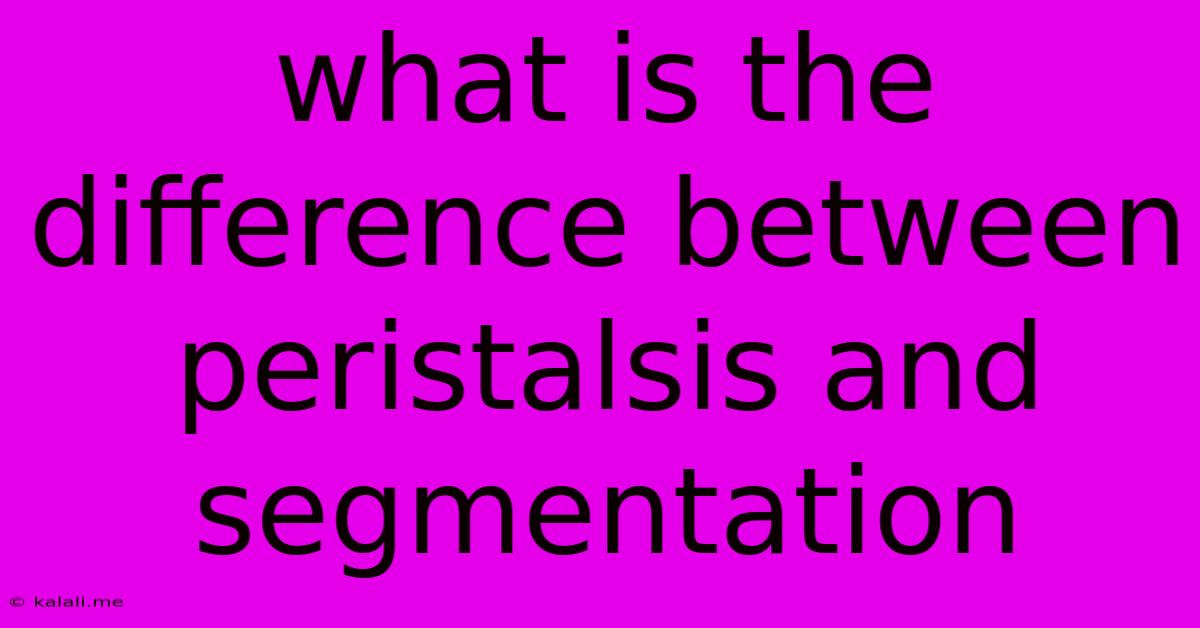What Is The Difference Between Peristalsis And Segmentation
Kalali
Jun 15, 2025 · 3 min read

Table of Contents
Peristalsis vs. Segmentation: Understanding the Differences in Digestive Muscle Contractions
Understanding how your digestive system moves food through your body is crucial to understanding your overall health. This article delves into the fascinating world of gut motility, exploring the key differences between peristalsis and segmentation – two vital types of muscle contractions responsible for food propulsion and digestion. Learn how these distinct processes work together to ensure efficient nutrient absorption.
What is Peristalsis?
Peristalsis is a wave-like muscular contraction that propels food through the digestive tract. Imagine squeezing a toothpaste tube from the bottom – that's essentially how peristalsis works. This coordinated movement involves the circular and longitudinal muscles in the esophagus, stomach, small intestine, and large intestine. The circular muscles contract behind the bolus (the mass of food), while the longitudinal muscles contract ahead of it, creating a wave of movement that pushes the food forward.
Key characteristics of peristalsis:
- Direction: Primarily unidirectional, moving food in one direction – orally to anally.
- Purpose: To propel the bolus along the gastrointestinal tract.
- Speed: The speed varies depending on the location in the digestive tract; it's faster in the esophagus and slower in the large intestine.
- Mechanism: Involves coordinated contractions of circular and longitudinal muscles.
- Role in Digestion: Primarily involved in moving the food, not directly in breaking it down.
What is Segmentation?
Unlike the continuous, unidirectional movement of peristalsis, segmentation is a rhythmic contraction and relaxation of the circular muscles in the small intestine. This creates a back-and-forth movement, which mixes the chyme (partially digested food) with digestive enzymes and allows for better nutrient absorption. Think of it like kneading dough – it mixes the ingredients thoroughly.
Key characteristics of segmentation:
- Direction: Primarily bidirectional, involving both forward and backward movements.
- Purpose: To mix and churn the chyme, increasing contact with the intestinal wall for better nutrient absorption.
- Speed: The rate of segmentation varies depending on the location and digestive status.
- Mechanism: Primarily involves the contraction and relaxation of circular muscles.
- Role in Digestion: Directly contributes to the digestion process by maximizing contact between chyme and the intestinal lining, facilitating absorption.
Key Differences Between Peristalsis and Segmentation:
| Feature | Peristalsis | Segmentation |
|---|---|---|
| Movement | Wave-like, unidirectional | Rhythmic, bidirectional |
| Muscles | Circular and longitudinal muscles | Primarily circular muscles |
| Primary Purpose | Food propulsion | Mixing and churning of chyme |
| Location | Esophagus, stomach, small intestine, large intestine | Primarily small intestine |
| Role in Digestion | Primarily transport; minimal direct digestion | Direct involvement in nutrient absorption |
Clinical Significance:
Dysfunction in either peristalsis or segmentation can lead to various digestive problems. For example, impaired peristalsis can cause constipation, while issues with segmentation might contribute to malabsorption syndromes.
In Conclusion:
Peristalsis and segmentation are two distinct yet complementary processes vital for proper digestion. Peristalsis ensures the efficient movement of food through the digestive tract, while segmentation maximizes nutrient absorption by thoroughly mixing the chyme. Understanding these processes provides valuable insight into the complexity and efficiency of the human digestive system. Further research into the intricacies of these movements continues to reveal more about the maintenance of gut health and the prevention of digestive disorders.
Latest Posts
Latest Posts
-
What Is 1 Watt Equivalent To
Jun 15, 2025
-
Compare And Contrast Prejudice And Discrimination
Jun 15, 2025
-
College Of The Desert Acceptance Rate
Jun 15, 2025
-
Atoms Combine In Simple Whole Number Ratios To Form Compounds
Jun 15, 2025
-
Which Of The Following Is Not A Symptom Of Alcoholism
Jun 15, 2025
Related Post
Thank you for visiting our website which covers about What Is The Difference Between Peristalsis And Segmentation . We hope the information provided has been useful to you. Feel free to contact us if you have any questions or need further assistance. See you next time and don't miss to bookmark.